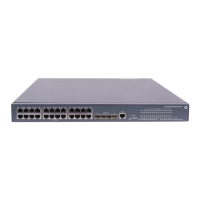129
MAC-based VLAN configuration example
Network requirements
As shown in Figure 42:
• GigabitEthernet 1/0/1 of Device A and Device C are each connected to a meeting room. Laptop
1 and Laptop 2 are used for meetings and might be used in either of the two meeting rooms.
• Different departments own Laptop 1 and Laptop 2. The two departments use VLAN 100 and VLAN
200, respectively. Each laptop must be able to access only its own department server, no matter
which meeting room it is used in.
• The MAC address of Laptop 1 is 000D-88F8-4E71, and that of Laptop 2 is 0014-222C-AA69.
Figure 42 Network diagram
Configuration consideration
• Create VLANs 100 and 200.
• Configure the uplink ports of Device A and Device C as trunk ports, and assign them to VLANs 100
and 200.
• Configure the downlink ports of Device B as trunk ports, and assign them to VLANs 100 and 200.
Assign the uplink ports of Device B to VLANs 100 and 200.
• Associate the MAC address of Laptop 1 with VLAN 100, and associate the MAC address of Laptop
2 with VLAN 200.
Configuration procedure
1. Configure Device A:
# Create VLANs 100 and 200.
<DeviceA> system-view
[DeviceA] vlan 100
Device A
Device C
Device B
Server1
IP: 1.1.1.1/24
Server2
IP: 1.1.2.1/24
GE1/0/1 GE1/0/1
Laptop1
IP: 1.1.1.2/24
MAC: 000d-88f8-4e71
Laptop2
IP: 1.1.2.2/24
MAC: 0014-222c-aa69
VLAN 100 VLAN 200
GE1/0/2
GE1/0/2
GE1/0/3
GE1/0/4
GE1/0/14
GE1/0/13
VLAN 100 VLAN 200

